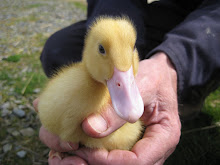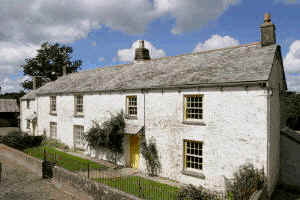 It's been a long while since I blogged, but tonight I had the urge to tell you about my Pilgrim geese.
It's been a long while since I blogged, but tonight I had the urge to tell you about my Pilgrim geese.They are a rather rare breed of sex-linked geese, with the ganders white and the females grey. When they hatch the fluff on the females is olive greeny grey, the males yellow with some paler grey on their backs. You can look for hours at a collection of baby ganders wondering if perhaps there is one, please just one, female in the group.
Although nearly all the eggs my trio produced were fertile, the successful hatching rate of the Pilgrim is low - no wonder they're a rare breed - and I managed to hatch just ten through artificial incubation, although the batch I left under the goose came to naught.
There are still four fluffy goslings in a cage run, keeping them safe from predators - cats, dogs, foxes, buzzards and the like, but after a week of letting the adults roam round the run with the older goslings, they are now happily integrated as a flock.
They belong in the orchard really, but I can't bear to put them up there as they are a quiet breed and may not make enough noise to alert me to a possible fox presence. To be honest, an inevitable fox presence - we are overrun with them on the farm and at least one new litter of cubs was born this year. So they are living in the farmyard, with a spacious stable to house them at night, and during the day I can stand and stare as they stretch out a leg, a wing, and do their flamingo impersonations. Or dabble in puddles, or tease the dogs, or carry bits of stray wood around, or nibble at the mudguards of my car, or the headlamps of visitor's cars, or sift the corn, or sit and stand and sit again.
The six goslings in the flock are like child sized cellos - identical in every way to their parents, just slightly miniaturised. They are long past the gawky fluffy stage, the strangely ugly time that every goose goes through, a sort of adolescent, pubescent gangly phase when only a mother could love them.
















